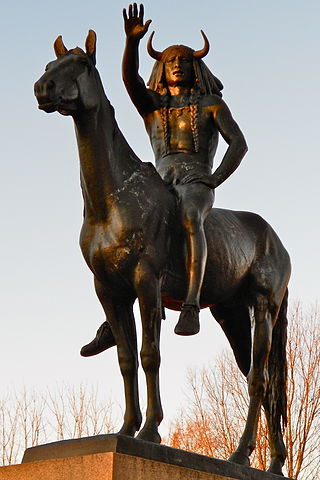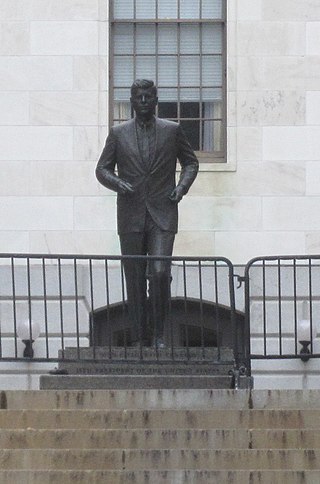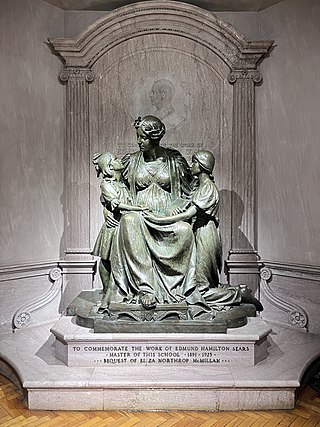
Cyrus Edwin Dallin was an American sculptor best known for his depictions of Native Americans. He created more than 260 works, including the Equestrian Statue of Paul Revere in Boston; the Angel Moroni atop Salt Lake Temple in Salt Lake City; and Appeal to the Great Spirit (1908), at the Museum of Fine Arts, Boston. He was also an accomplished painter and an Olympic archer.

Appeal to the Great Spirit is a 1908 equestrian statue by Cyrus Dallin, located in front of the Museum of Fine Arts, Boston. It portrays a Native American on horseback facing skyward, his arms spread wide in a spiritual request to the Great Spirit. It was the last of Dallin's four prominent sculptures of Indigenous people known as The Epic of the Indian, which also include A Signal of Peace (1890), The Medicine Man (1899), and Protest of the Sioux (1904).

Anne Whitney was an American sculptor and poet. She made full-length and bust sculptures of prominent political and historical figures, and her works are in major museums in the United States. She received prestigious commissions for monuments. Two statues of Samuel Adams were made by Whitney and are located in Washington, D.C.'s National Statuary Hall Collection and in front of Faneuil Hall in Boston. She also created two monuments to Leif Erikson.

Bashka Paeff, was an American sculptor active near Boston, Massachusetts.

The Medicine Man is an 1899 bronze equestrian statue by Cyrus Edwin Dallin located on Dauphin Street, west of 33rd Street, in Fairmount Park in Philadelphia. The statue portrays an indigenous American medicine man.

The Cyrus Dallin Art Museum (CDAM) in Arlington, Massachusetts, United States is dedicated to displaying the artworks and documentation of American sculptor, educator, and Indigenous rights activist Cyrus Dallin, who lived and worked in the town for over 40 years. He is well known for his sculptural works around the US including The Scout in Kansas City, Missouri, TheSoldiers' and Sailors' Monumentin Syracuse, New York and The Signal of Peace in Chicago. Locally, he is best known for his iconic Appeal to the Great Spirit and Paul Revere Monument statues, both located in Boston.

An equestrian statue of Joseph Hooker is installed outside the Massachusetts State House, facing Beacon Street in Boston, in the United States.

A statue of Horace Mann by Emma Stebbins is installed outside the Massachusetts State House, in Boston, Massachusetts, United States.

A statue of Quaker religious martyr Mary Dyer by Sylvia Shaw Judson is installed outside the Massachusetts State House, in Boston, Massachusetts, United States.

A statue of Daniel Webster by Hiram Powers is installed outside the Massachusetts State House, in Boston, Massachusetts, United States.

A statue of Tadeusz Kościuszko by Theo Alice Ruggles Kitson is installed in Boston's Public Garden, in the U.S. state of Massachusetts.

A statue of Henry Cabot Lodge by Raymond Averill Porter is installed outside the Massachusetts State House, in Boston, Massachusetts, United States.

An equestrian statue of Paul Revere by Cyrus Edwin Dallin is installed at Paul Revere Mall near the Old North Church in Boston, Massachusetts.

Triton Babies Fountain is a fountain and sculpture by Anna Coleman Ladd, installed in Boston's Public Garden, in the U.S. state of Massachusetts. It features a bronze sculpture, cast in 1922, that depicts a boy and girl and measures approximately 2 ft. 3 in. x 19 in. x 39 in. The statue rests on a granite base measuring approximately 2 ft. 6 in. x 18 in. x 31 in. The work was surveyed as part of the Smithsonian Institution's "Save Outdoor Sculpture!" program in 1993.

An equestrian statue of George Washington by Thomas Ball is installed in Boston's Public Garden, in the U.S. state of Massachusetts.

A statue of John Glover by Martin Milmore is installed along Boston's Commonwealth Avenue Mall, in the U.S. state of Massachusetts.

A statue of John F. Kennedy by Isabel McIlvain is installed outside the Massachusetts State House in Boston, Massachusetts, United States.

A statue of Josiah Quincy III by Thomas Ball is installed outside Boston's Old City Hall, in the U.S. state of Massachusetts. The sculpture belongs to the City of Boston.

Alma Mater (1916) is a three-figure sculpture by Cyrus E. Dallin in the Mary Institute and St. Louis Country Day School in Ladue, Missouri that was known as one of his more prominent works at the time and is considered to be among his finest achievements by Kent Ahrens. The sculpture is made of cast bronze and sits on a pediment of pink Tennessee marble with a stone backing that has two ionic pilasters supporting an arching molding. The backing panel also has a bas relief profile portrait of the honoree, Professor Edmund Sears, that is partially obstructed by the bronze figures.

Signing of the Mayflower Compact (1922) is a fifteen-figure, bas-relief sculpture by Cyrus E. Dallin located at the base of Monument Hill below the Pilgrim Monument in Provincetown, Massachusetts. The sculpture is one of three major commissions he received as part of the Pilgrim Tercentenary in 1920. The other two were the statue of Massasoit in Plymouth, Massachusetts and the Pilgrim half dollar, which featured renditions of a pilgrim and the Mayflower under sail.





















